Image J Getting Results to Read Out as Rgb
Types of colour images
Images with color come in three different forms: pseudo-colour, 24-flake RGB prototype, or color blended image.
Pseudo-color
A pseudo-colored image has a single channel, (i.e. gray) epitome that has colour ascribed to information technology via a "Look Up Table" or LUT (a.thou.a. palette, color tabular array). This is a table of grey values (zip to 256 or 4095 whether 8-bit or 12-bit grey) with accompanying cerise, greenish and blue values. Instead of displaying grey, the image displays a pixel with a defined amount of each color. Differences in color in the pseudo-colored image reflect differences in intensity of the object rather than differences in color of the specimen that has been imaged. For pseudo-color functions run into afterwards.
24-bit RGB images
The colors in RGB images (24-bit with 8-$.25 for each of the red, light-green and blue channels) are used to show multi-aqueduct images. The colors are designed to reflect 18-carat colors (i.eastward. the green in an RGB image reflects dark-green color in the specimen). In that location are several RGB functions in Republic of the fiji islands. Native functions tin be found in Epitome › Color .
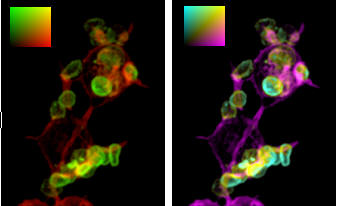
Colour Blended Images
A colour blended image is similar to the color images one would find in the image processing software Photoshop. In Photoshop these images are fabricated of "layers", and in Fiji they are made of "channels". Both "layers" and "channels" are the same idea. The advantages of using this type of image instead of RGB images include:
- Each channel is kept separate from the others and can be turned on or off using the 'Channels Tool' ( Paradigm › Color › Channels Tool ). You have the option of viewing the paradigm equally a composite of all or some of the different channels, every bit private channels, or as individual greyscale channels. In that location is a button labeled 'More than' at the bottom of the window that allows you to make a composite, convert the prototype to RGB, merge or separate channels, edit the image's LUT, or choose new aqueduct colors from a list.
- Each original channel can be kept as xvi-flake.
- More than iii channels tin be merged and kept separate. Each channel can be selected via the scroll bar at the bottom of the window.
- The contrast and effulgence of private channels tin be adapted after merging.
Color composite images tin be converted to 24-bit RGB via the 'Channels Tool' dialog box.
The disadvantage of the Composite image type is that this relatively recent Fiji development is not supported by all existing plugins. Quondam the composite can revert to a multi-piece stack. To convert it back to a composite you can apply the menu control Image › Color › Make Composite .
Merging multi-aqueduct images
Interleaved multi-channel experiments
Multi-aqueduct experiments acquired on some systems are imported with the different channels interleaved, i.e. Slice 1 is Timepoint1-channel1 and Slice 2 is Timepoint1-channel2. The stack needs to exist "De-interleaved" before it can exist RGB-merged. This can be done with Paradigm › Stacks › Tools › Deinterleave and entering the number of channels in the dialog (typically "2"). You can too choose to check a box for whether or non the source stacks should be kept. The two stacks can and so be merged via: Epitome › Color › RGB merge .
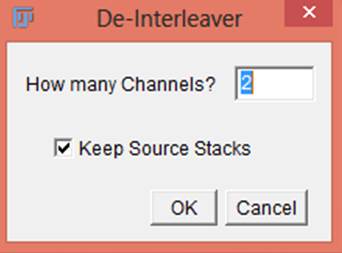
RGB color merging
The native Republic of the fiji islands role Epitome › Color › Merge Channels… can be used to merge blood-red, green and/or bluish aqueduct images or Image Stacks
This reduces 16-scrap images to eight-bits (based on the current Effulgence and Contrast values) then generates a 24-bit RGB image.
An culling to the normal Scarlet-Light-green merge is to merge the images based on Cyan and Magenta, or Cyan-Xanthous or any other colour combination.
This can aid visualization of colocalization due to our poor perception of red and green colors. The Colour_merge plugin gives the user the option of using the 'difference' arithmetics processing on the prototype stacks yous select. This is not strictly a merge (when cyan and magenta merge they produce white, not yellow) just facilitates visualization of the separate channels (See Demandolx and Davoust, J. Microscopy, 1997 v185. p21 i). You can perform a true merge if you turn off the "Difference" selection.
Run the plugin and select the two images to be merged. Select the desired colors from the drop-downwardly options.
Merging transmitted lite and fluorescence images
Fluorescence and transmitted light brightfield images can be merged with the Paradigm › Colour › Merge Channels… . This instruction lets yous than choose the C4 (greyness) option. This can foreclose a 'washed out' look to the fluorescence.
This too reduces 16-bit images to viii-$.25 (based on the current Brightness and Dissimilarity values) and so generates a 24-bit RGB epitome.
Merging images to a color composite
The menu command Image › Colour › Merge Channels… opens a dialog to merge grayness, red, green, blue, cyan, magenta, and yellow channels to a new composite image.
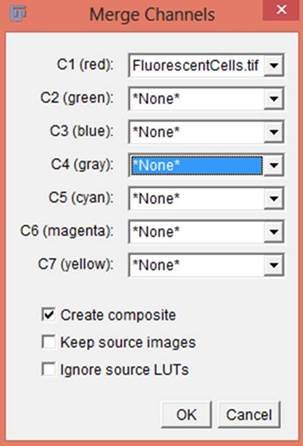
Splitting multi-channel Images
An RGB image or stack can be split to the respective red, green and blue paradigm components using the bill of fare command Image › Colour › Dissever Channels .
Sometime a merged RGB paradigm may need to be displayed along with the dissever channels in a concluding figure. This can be done with the "RGB to Montage" plugin.
It works with single slice RGB images. A new RGB stack is created, channel 1 beingness the cherry channel; two the green and 3 the blue. The 4th slice is the merged piece. If a channel is empty (e.yard. a cherry-light-green merged image volition have no blueish) and then the piece is omitted. So the plugin prompts you for the layout of the montage. You have the option to alter the width of the white border between the image panels. If the 'Pseudo-color 'option is off, each channel will be greyscale. If scale bar size is set to zero, no scale bar will be added.
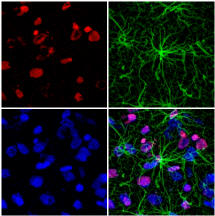
Color Composite
The blended can be reverted to a greyscale stack via the menu command Image › Hyperstacks › Hyperstack to Stack . The channels can be subsequently split up to individual images via the menu command Image › Stacks › Stack to Images .
Pseudo-color
Judicious use of LUTs can exist very useful in highlighting the desired features of an image. The human eye tin can perceive relatively few shades in one image. Pseudo-coloring images can make information more than visible
Traditional "Greenish" LUT

Enhanced "Green Hot" LUT
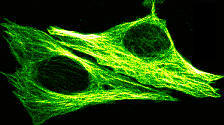
Microtubules under nucleus now more apparent
Have a play and see which LUT helps illustrates the features in your image.
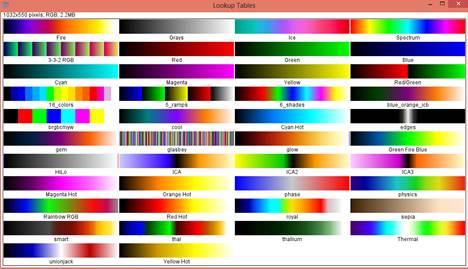
Montage compiled from a stack generated using the menu commands Image › Color › Brandish LUTs .
Different LUTs are available via the menu commands Image › Lookup Tables .
When using a not-standard LUT information technology may be useful to add a greyscale ramp so the user tin judge which colour represents which greyness-scale value. A ramp can be added with the native part Analyze › Tools › Scale Bar… . If at that place is no space for the ramp, endeavour enlarging the image canvas with the bill of fare command Epitome › Conform › Canvas Size… .
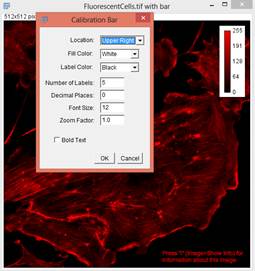
Analyze › Tools › Calibration Bar…
Source: https://imagej.net/imaging/color-image-processing
Enviar um comentário for "Image J Getting Results to Read Out as Rgb"